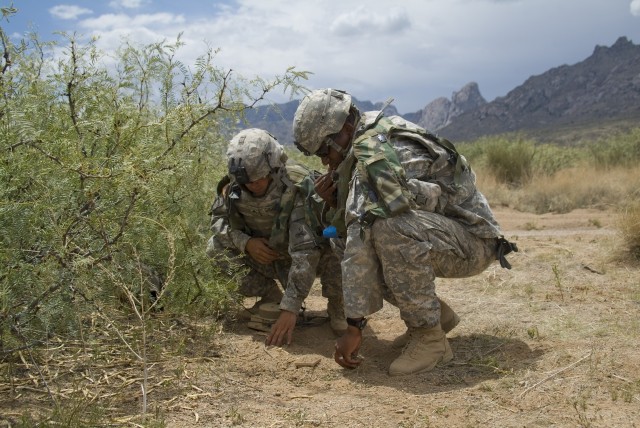
FORT BLISS, Texas (Aug. 24, 2009) -- Soldier designs and feedback are helping shape combat systems being developed at White Sands Missile Range, N.M., and Fort Bliss.
New Tactical Unattended Ground Sensors being developed by the Army modernization program are currently being tested by Soldiers.
Loaded with cameras, infrared sensors, microphones and seismic sensors, the T-UGS can be placed in an area that Soldiers want to monitor. If any of the sensors are tripped, it will alert the Soldiers who can then use the sensor data to determine what action to take.
"Just from the spike in the ground we can get an alert, and another (sensor) in the network can get an image...it can take a picture of a three-man squad and get it up to get an ID of someone in the squad," said Lt. Col. Darren Klemmens, operations officer and deputy brigade commander with the Army Evaluation Task Force.
Software in the sensor package can also enable the sensors to make basic identifications on their own. It allows the sensors to tell the difference between things like tanks, wheeled vehicles, infantry and helicopters, and then sends that information to the Soldiers monitoring the sensors.
What makes these sensors different from previous designs is that the batch the Soldiers are using to develop possible tactics, techniques and procedures have been redesigned and modified based on feedback from the Soldiers themselves.
The previous design of the sensor packages looked like a pair of soda cans stacked on top of each other with a thick semi-rigid antenna sticking out of the top. The original intent was for the Soldiers to bury most of the pod, with only the microphones, cameras and antenna exposed.
Soldiers disliked that design, as it took too long to dig a proper hole to conceal the sensor, a task made even more difficult in rocky ground.
"It's all a learning process --you have to get out there and actually use this equipment," said Klemmens.
At the request of the Soldiers, the casing was redesigned to a flat box-shaped casing about the size of a pie plate, and the semi-rigid antenna replaced with a lighter flexible "spider antenna."
The flat shape allows the sensor to be easily concealed by just covering it over with a little dirt or vegetation instead of requiring a hole to be dug. The requested antenna, along with a new transmitter, gives the system an increased range as well, allowing it to easily send data to Soldiers several kilometers away in open terrain, without the need for repeaters or other range-extending equipment.
In dense terrain, each sensor can act as a repeater for the rest of the sensors in a network which helps keeps the sensors' range long in an environment where they can be more critical to a Soldier's mission and personal safety.
"It gives us the opportunity to cover areas you otherwise couldn't. In restricted terrain, where you can't see very far, this gives you the ability to cover your back," said 1st Lt. John Auger, a scout platoon leader from the 2nd Combined Arms Battalion, the unit fielding the new systems in the Force Development Test and Evaluation.
Ease of use was a big concern of the Soldiers, who wanted to spend as little time as possible setting up the systems giving them more time to focus on the mission itself. To facilitate this, the Soldier requested a connection-verification button be added.
The new feature now allows Soldiers to check the connection status of a sensor with just the press of a button, allowing them to quickly confirm connectivity and place the sensor instead of having to continually adjust the location of the sensor and return to a base station or control vehicle to make sure it is working properly.
Another new feature added, based on Soldier feedback, is a standardized connector for the various components of the sensors. The new connector makes the system easier to maintain in the field.
"We couldn't fix (broken sensors) before, now we can," said training developer Capt. David Dilly.
The new connector also makes it easier to upgrade the sensors, as well as allow for the Soldiers to customize the sensors to meet specific mission requirements. "Further development will allow for different combinations of sensors and new sensors can be added as they are developed," Dilly said.
While the Soldiers are in the field testing out the new sensors, they're still working on new ways to improve the system and make its deployment and use easier. One such improvement the Soldiers are working on is a special backpack to carry the sensors.
"The Soldiers are drawing up the design so I can take it to the contractor," said Dilly.

Social Sharing